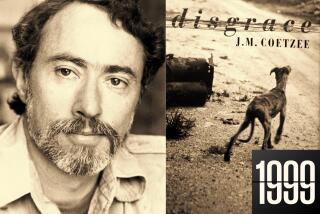1991 LOS ANGELES TIMES BOOK PRIZES : SCIENCE & TECHNOLOGY : A Conspiracy of Silence
Candor about their failures--economic, technological or otherwise--was never a strong suit of the Soviet Union’s old Communist bosses. They kept silent about plane crashes, refused to acknowledge mishaps in space, waffled about such mundane matters as poor crops or shortages of materials. Even as late as May 1985--11 months before Chernobyl and well after the first glimmerings of glasnost --the Kremlin’s new energy minister ordered subordinates not to discuss adverse health effects of nuclear or other power-generating facilities in public.
So it came as no surprise that Moscow kept mum when Reactor No. 4 at the Chernobyl nuclear-power station exploded in the early morning hours of April 26, 1986. Not until Swedish scientists detected a large cloud of radiation over their country 10 days later did the Kremlin finally acknowledge the worst nuclear accident in history. Even then, it stonewalled, hiding the full nature of the nightmare unfolding in the heart of the Ukraine’s breadbasket region, just 50 miles north of Kiev, not only from the outside world but from its own people as well.
“The Truth About Chernobyl,” Grigori Medvedev’s excruciatingly detailed and candid reconstruction of the disaster, stands in remarkable contrast to this long history of prevarication. Even five years later, after many other horror stories have been told about the Kremlin’s years of misrule, Medvedev’s revelations still have the power to move and shock. Blunt and colloquial, his book is popular science writing of the highest order.
At the time of the accident, Medvedev was a ranking engineer in the Soviet nuclear establishment (and part-time writer) whose career had included an early stint at Chernobyl. He began interviewing eyewitnesses almost immediately after learning of the disaster. Some of his sources were already on their deathbeds from exposure to the lethal radiation.
The story he gathered is gripping on several levels. As a technological thriller, it’s as much of a page-turner as anything spun out by Tom Clancy or Robert Ludlum, except that it’s all too true. It’s also a wrenchingly human chronicle, filled with villains and heroes, massive deception and great suffering. Finally, it’s a morality tale of almost Promethean proportions, about highly intelligent people who delude themselves into believing they can snatch the heavenly fires without paying the price.
Ironically, the immediate cause of the calamity was mundane: one of those standard safety tests--a mock power failure--that the managers of nuclear power plants periodically stage to check out their protective procedures. The chief engineer was so cocksure of Reactor No 4. and its safety systems that he intentionally immobilized a switch that might have brought a cascade of cooling water on the out-of-control reactor. But that was hardly the only error.
Even after the countdown for the scheduled test began, any number of steps might have been taken--or avoided--to prevent the accident. Indeed, as late as 90 seconds before explosion, the plant’s operators could have gotten safely through the night by throttling back manually on the reactor’s rising power levels. Instead, the chief engineer pressed on. “Another two or three minutes,” he exulted, “and it will all be over! Get moving, boys!”
Though the doomed power plant was quickly flooded with dangerous radionucleotides after the blast ripped off the reactor’s 1,000-ton lid, many of the operators courageously stayed at their posts, trying to regain control of the plant. Two died immediately. Other casualties soon followed. Uninformed about the risk, firefighters rushed into the building, and later military helicopter pilots flew directly into the lethal plume overhead in order to drop sand on the exposed reactor.
Nonetheless, radiation levels soared in the reactor’s vicinity; Medvedev reckons they were equivalent to the product of 10 Hiroshima-type bombs. Still, the high command in Moscow refused to order an evacuation of the area. For several days, children continued playing in the streets of nearby Pripyat, only three miles away. Sunbathers basked in the spring warmth, and life was allowed to go on in the lush farming area. Because of the official dawdling, thousands of people were needlessly endangered. Later, the bodies of some of the victims turned out to be so radioactive they had to be buried in lead coffins.
Was the accident inevitable? Medvedev thinks so, considering the prevailing attitude toward nuclear power. Reactors had long been operated “on the razor’s edge . . . a hair’s breadth away from breakdown or disaster,” he says, because the Kremlin was so in the thrall of nuclear power--and of the leading scientists who urged it--that any words of skepticism were ignored, if not forbidden. Even efforts to learn from the American accident at Three Mile Island in 1979 were discouraged, Medvedev says, because they “would have clashed with the official line about the complete safety of nuclear power stations.”
In any case, Medvedev contends, the type of reactor used at Chernobyl was flawed from the start, but its designer had so much clout that top officials brushed off all concerns. Nor did it help matters when engineers without any experience in nuclear power were placed in key management positions at facilities like Chernobyl. Medvedev calls this attitude nothing less than “criminal thoughtlessness and complacency.”
Yet complacency wasn’t limited to Moscow. It infected the entire system. Plant operators knew better than to question reactor safety if they wanted to advance. They never circulated reports on glitches, problems or reactor shutdowns, lest the illusion of infallibility be shattered, and so no one could learn from anyone else’s experiences. “The fact is that there was a conspiracy of silence,” Medvedev says.
Many commentators have pointed out that Chernobyl was the last straw, in a succession of setbacks, that finally broke the people’s tolerance of Communist mismanagement. Medvedev himself says as much. Still, even while a corrupt, secretive regime bears a heavy responsibility for Chernobyl, no one in the West ought to gloat. Though they had far less serious consequences, the nuclear accidents at Three Mile Island and other Western installations showed some worrisome similarities to Chernobyl. At TMI, for example, control-room operators also refused to believe what their instruments were telling them.
At times Medvedev’s account reads like a polemic against nuclear power. Certainly, he provides enough evidence of human incompetence in the design and operation of reactors to give even the most staunch proponents second thoughts about their safety. (Here Medvedev’s editors might have helped lay readers understand reactor complexities better by including a few diagrams.) But nuke-bashing isn’t his intent. Instead, he argues that if we’re going to tap the energy of the atom--like the late Andrei Sakharov, who provides an introduction, he sees no alternative--we ought at the very least do it with prudence, technological sophistication and, above all, complete openness about its risks and benefits.
Science and Technology Prize
THE TRUTH ABOUT CHERNOBYL, by Grigori Medvedev; Evelyn Rossiter, translator (Basic Books)
Nominees
THE ASCENT OF THE MIND: Ice Age Climates and the Evolution of Intelligence, by William Calvin (Bantam Books)
LONELY HEARTS OF THE COSMOS: The Scientific Quest for the Secret of the Universe, by Dennis Overbye (HarperCollins)
THE MAN WHO KNEW INFINITY: A Life of the Genius Ramanujan, by Robert Kanigel (Charles Scribner’s Sons)
WALKING WITH THE GREAT APES, by Sy Montgomery (Houghton Mifflin)
More to Read
Sign up for our Book Club newsletter
Get the latest news, events and more from the Los Angeles Times Book Club, and help us get L.A. reading and talking.
You may occasionally receive promotional content from the Los Angeles Times.






